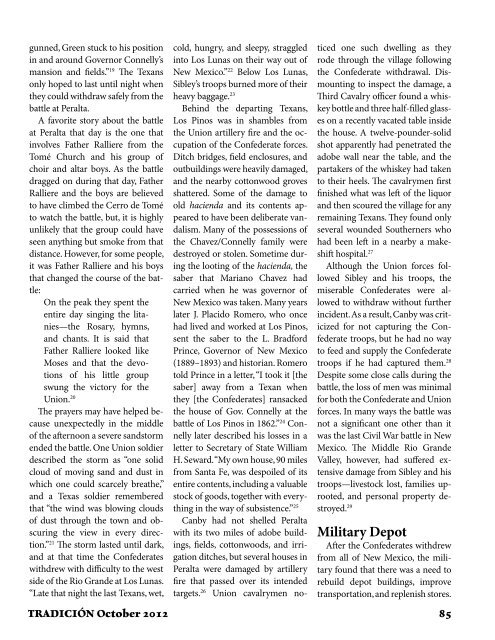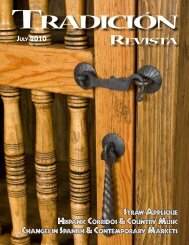tradicion revista fall 2012 - LPD Press & Rio Grande Books
tradicion revista fall 2012 - LPD Press & Rio Grande Books
tradicion revista fall 2012 - LPD Press & Rio Grande Books
Create successful ePaper yourself
Turn your PDF publications into a flip-book with our unique Google optimized e-Paper software.
gunned, Green stuck to his position<br />
in and around Governor Connelly’s<br />
mansion and fields.” 19 The Texans<br />
only hoped to last until night when<br />
they could withdraw safely from the<br />
battle at Peralta.<br />
A favorite story about the battle<br />
at Peralta that day is the one that<br />
involves Father Ralliere from the<br />
Tomé Church and his group of<br />
choir and altar boys. As the battle<br />
dragged on during that day, Father<br />
Ralliere and the boys are believed<br />
to have climbed the Cerro de Tomé<br />
to watch the battle, but, it is highly<br />
unlikely that the group could have<br />
seen anything but smoke from that<br />
distance. However, for some people,<br />
it was Father Ralliere and his boys<br />
that changed the course of the battle:<br />
On the peak they spent the<br />
entire day singing the litanies—the<br />
Rosary, hymns,<br />
and chants. It is said that<br />
Father Ralliere looked like<br />
Moses and that the devotions<br />
of his little group<br />
swung the victory for the<br />
Union. 20<br />
The prayers may have helped because<br />
unexpectedly in the middle<br />
of the afternoon a severe sandstorm<br />
ended the battle. One Union soldier<br />
described the storm as “one solid<br />
cloud of moving sand and dust in<br />
which one could scarcely breathe,”<br />
and a Texas soldier remembered<br />
that “the wind was blowing clouds<br />
of dust through the town and obscuring<br />
the view in every direction.”<br />
21 The storm lasted until dark,<br />
and at that time the Confederates<br />
withdrew with difficulty to the west<br />
side of the <strong>Rio</strong> <strong>Grande</strong> at Los Lunas.<br />
“Late that night the last Texans, wet,<br />
cold, hungry, and sleepy, straggled<br />
into Los Lunas on their way out of<br />
New Mexico.” 22 Below Los Lunas,<br />
Sibley’s troops burned more of their<br />
heavy baggage. 23<br />
Behind the departing Texans,<br />
Los Pinos was in shambles from<br />
the Union artillery fire and the occupation<br />
of the Confederate forces.<br />
Ditch bridges, field enclosures, and<br />
outbuildings were heavily damaged,<br />
and the nearby cottonwood groves<br />
shattered. Some of the damage to<br />
old hacienda and its contents appeared<br />
to have been deliberate vandalism.<br />
Many of the possessions of<br />
the Chavez/Connelly family were<br />
destroyed or stolen. Sometime during<br />
the looting of the hacienda, the<br />
saber that Mariano Chavez had<br />
carried when he was governor of<br />
New Mexico was taken. Many years<br />
later J. Placido Romero, who once<br />
had lived and worked at Los Pinos,<br />
sent the saber to the L. Bradford<br />
Prince, Governor of New Mexico<br />
(1889–1893) and historian. Romero<br />
told Prince in a letter, “I took it [the<br />
saber] away from a Texan when<br />
they [the Confederates] ransacked<br />
the house of Gov. Connelly at the<br />
battle of Los Pinos in 1862.” 24 Connelly<br />
later described his losses in a<br />
letter to Secretary of State William<br />
H. Seward. “My own house, 90 miles<br />
from Santa Fe, was despoiled of its<br />
entire contents, including a valuable<br />
stock of goods, together with everything<br />
in the way of subsistence.” 25<br />
Canby had not shelled Peralta<br />
with its two miles of adobe buildings,<br />
fields, cottonwoods, and irrigation<br />
ditches, but several houses in<br />
Peralta were damaged by artillery<br />
fire that passed over its intended<br />
targets. 26 Union cavalrymen no-<br />
ticed one such dwelling as they<br />
rode through the village following<br />
the Confederate withdrawal. Dismounting<br />
to inspect the damage, a<br />
Third Cavalry officer found a whiskey<br />
bottle and three half-filled glasses<br />
on a recently vacated table inside<br />
the house. A twelve-pounder-solid<br />
shot apparently had penetrated the<br />
adobe wall near the table, and the<br />
partakers of the whiskey had taken<br />
to their heels. The cavalrymen first<br />
finished what was left of the liquor<br />
and then scoured the village for any<br />
remaining Texans. They found only<br />
several wounded Southerners who<br />
had been left in a nearby a makeshift<br />
hospital. 27<br />
Although the Union forces followed<br />
Sibley and his troops, the<br />
miserable Confederates were allowed<br />
to withdraw without further<br />
incident. As a result, Canby was criticized<br />
for not capturing the Confederate<br />
troops, but he had no way<br />
to feed and supply the Confederate<br />
troops if he had captured them. 28<br />
Despite some close calls during the<br />
battle, the loss of men was minimal<br />
for both the Confederate and Union<br />
forces. In many ways the battle was<br />
not a significant one other than it<br />
was the last Civil War battle in New<br />
Mexico. The Middle <strong>Rio</strong> <strong>Grande</strong><br />
Valley, however, had suffered extensive<br />
damage from Sibley and his<br />
troops—livestock lost, families uprooted,<br />
and personal property destroyed.<br />
29<br />
Military Depot<br />
After the Confederates withdrew<br />
from all of New Mexico, the military<br />
found that there was a need to<br />
rebuild depot buildings, improve<br />
transportation, and replenish stores.<br />
TRADICIÓN October <strong>2012</strong> 85




